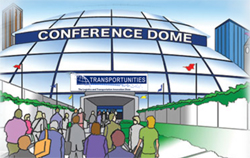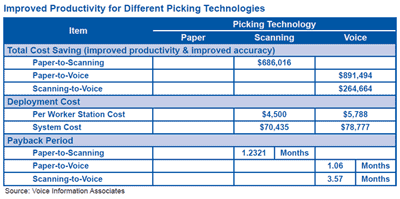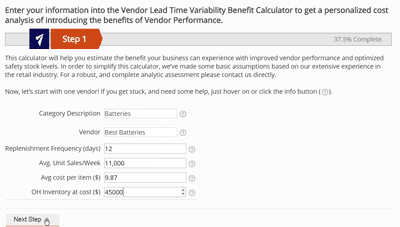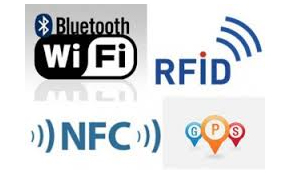 |
SUPPLY CHAIN NEWS BITES |
|
|
 |
Google Ups its eFulfillment Game |
 |
Walmart Continues to Change Its Store Mix, Invest in eCommerce |
 |
Oil Prices Plunge, Could Cause GeoPolitical Issues
|
 |
New Whole Foods Responsibly Grown Labels |
| |
|
|
|
|
2014 LOGISTICS AND TRANSPORTATION SHOW
|
 |
The Logistics and Transportation Insight and Solutions You Need - Without Leaving the Office
|

New Date!
October 22, 2014
|
|
| ONTARGET e-MAGAZINE |
Weekly On-Target Newsletter:
October 16, 2014 Edition
|
Cartoon, Google Express Expands, UPS Begs Retailers, Top RFID Apps and
more
|
|
|
|
Musings on Voice Technology 2014
I was on the road again this week, at the Vocollect/Honeywell partner conference in Dallas, as the keynote speaker on Tuesday morning.
This isn't a "trip report" - the conference is mostly inside baseball for voice technology leader Vocollect and its reseller channels (product plans, marketing programs, etc.), but I thought it may make sense to use the event as a catalyst to offer some perspective on voice, both traditionally as well as where we may be headed in use of voice across supply chain processes.
| GILMORE SAYS: |
"There is just one problem with sortation systems. There are no good options for picking those cases - but voice provides the answer."
WHAT DO YOU SAY?
Send us your
Feedback here
|
I am a big fan of voice in logistics/distribution, so I want to be clear about that up front. To make sure everyone understands what voice technology is all about, it involves either specialized voice terminals or more traditional radio frequency devices that have voice capabilities built in such that distribution center workers interact via voice inputs to the system and audio commands as to what to do back from the system.
This involves one of two high level options: (1) a sort of dedicated, self-contained voice system that interacts in big data blocks with a Warehouse Management System or similar piece of software (meaning the voice system receives say a group of picks and locations from the WMS, and then returns what work was done when it is complete); or (2) a more real-time, direct integration with the WMS, which sends out commands via voice (through a headset connected to the terminal) dynamically, just like it does with a traditional RF terminal.
In either case, in a typical order picking application, a worker is first told what location to go to via a voice command. The worker confirms he/she is at the right location by saying the check digit of the location or scanning its bar code. Once confirmed, the system tells the worker how many items/cases to pick, and the worker confirms by speaking that the work has been completed, upon which he/she gets another assignment.
There is of course more nuance than that, such as the ability to have commands repeated and such, but those are the basics. The voice software translates WMS or other software commands from data to voice prompts, and turns voice responses back into data through "voice recognition" to be sent to the WMS.
Virtually all higher end WMS systems today have prebuilt voice interfaces of one kind or another (though usually just in select areas). Most second tier, homegrown, or older systems do not, where a variety of options to implement voice can be explored.
The advantages of voice are simple but powerful - since operators are largely interacting with the system via a headset, they have both their hands and their eyes free versus holding a terminal and looking at its screen. The voice system also sort of inherently pushes workers along in a way an RF-based application does not.
In many cases, these advantages will deliver 15% or more improvements in productivity, along with, perhaps surprisingly, an improvement in accuracy/quality.
In support of that statement, a group called Voice Information Associates did a detailed, engineering type study a couple of years ago, based on a one-shift DC operation that processes about 20,000 order lines per day, with a wage rate of $16.00 per hour and a cost per picking error of $12.00. The analyses found Voice would improve picking productivity in terms of lines per hour about 32% over paper, and about 15% over wireless scanning, representing significant savings, as summarized in the table below.
|
|
A few quick points:
Voice is especially valuable for efulfillment: Voice can benefit most every company, but may be extra attractive for efulfillment operations. Why? First, because this almost always involves working at the "eaches" level of picking, where voice is extra strong, and second because many/most of these operations are struggling to find profitability.
Taking out 15% or so out of DC labor, often close to 50% of total distribution costs for an efulfillment operation, can make a meaningful improvement to the bottom line. Awhile back, we created a simple spreadsheet calculator to do a quick analysis on this, which you will find here: New Voice Value Calculator for E-Fulfillment.
Voice and Labor Management Systems make a wonderful pairing: I am equally of fan of Labor Management, which again in great simplicity involves dynamically determining goals times for each piece of work done in the DC, and then reporting at an individual level how well workers are performing versus those standards.
I have myself seen LMS improve productivity say again in order picking from just 65% of standard when the system is turned on to 95% or so in a few months. That's a big savings. The impact of LMS might be slightly reduce because of the impact voice would also have on productivity, but if you are at one level unfortunate enough to have neither voice nor LMS, the good news is you have a tremendous upside to your current DC cost structure. If I was a consultant again, I would consider starting a voice + LMS practice.
The "killer voice app" in automation: The bread and butter DC automation system has historically been case pick-to-belt with downstream sortation. Our materials handling editor Cliff Holste has designed and implemented dozens of such systems, a couple of them with me. The savings come from grouping orders in a "wave" (there are other approaches) such that a picker only has to visit a location in a "pick module" once for all orders, placing all those cartons on the takeaway belt, to be distributed out by customer via the sorter. This cuts way down on travel time.
There is just one problem. There are no good options for picking those cases. You can have the operator just count them off, but sometimes the number of cases is very large. When Cliff and I did the totes Isotoner DC, it was common for a wave to require 80-90 or even more cases of the popular 80210 black umbrella - who can count that many right? The result is costly over- or under-picks.
You can alternatively scan each one, but that puts a big hit on productivity, as does "pick by label." All the choices are bad - except a voice system. With voice, the operator has his/her hands free, and could simply count each case as it is placed on the best, asking the system where he/she is in the count at any time.
Problem solved - not sure why this approach is not used more even today.
Where Voice will Head
In about 100% of futuristic movies, human directly interact with computers via voice (think "Hal" and hundreds of other examples).
This is where we will start to head - and perhaps sooner than you think. Let's start with some DC examples: a picker is directed to a picking location, but it empty. Should he/she wait to see if a replenishment is nearly there, or move on? In advanced WMS systems, there are usually some RF screen functions that allow the worker to get some insight into that question, but they take time.
Why shouldn't the picker be able to say "Location empty, replenishment status" or whatever. And the system says "Replen in two minutes, stay there," or "Replenishment delayed, go to location 5A32" or similar.
There are actually an almost unlimited number of such opportunities. Trying to close out a pallet? A worker says "where is the missing carton?" A supervisor asks "where are we against standard in order picking today?" There are hundreds more.
I can tell you there are in fact a few vendors working such capabilities. It will take the concept of "voice-enabled DC" to the next level.
Of course, this kind of voice-powered software will hardly be confined to WMS and distribution, though it may be easiest to implement there. But I believe that voice inquiry/response is a natural path once the age of "advanced analytics" is fully here. Won't supply chain planners, for example, want to ask the analytics engine questions, or ask for specific insight via voice rather than a mouse?
The science fiction guys almost always get it right in the end, don't they? It will happen here too, and maybe sooner in some cases than we may believe today.
What are your thoughts on voice technology in the DC? Do you see value in voice and LMS, or voice for case pick to belt? Can you see fully voice interactive supply chain apps? Let us know your thoughts at the Feedback button (email) or section (web form) below.
|
|

|
|
|
| |
|
|












